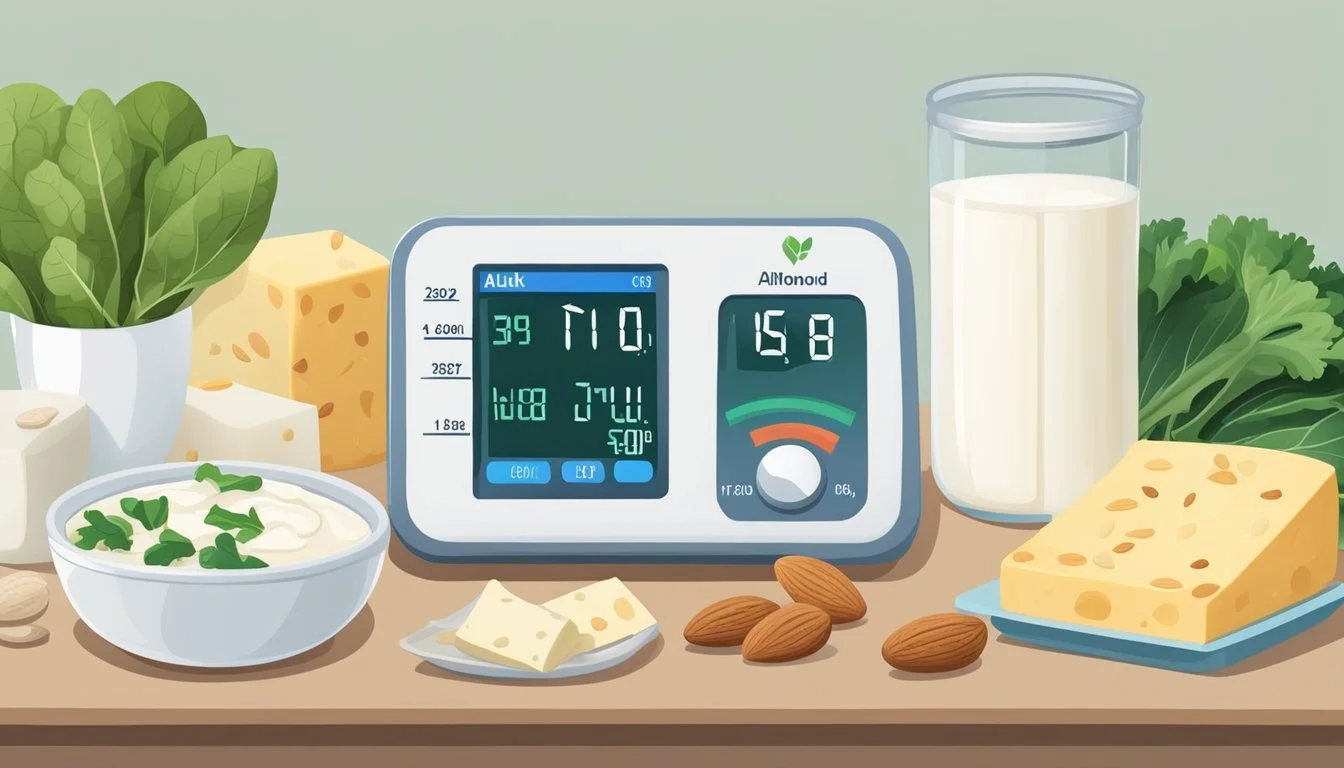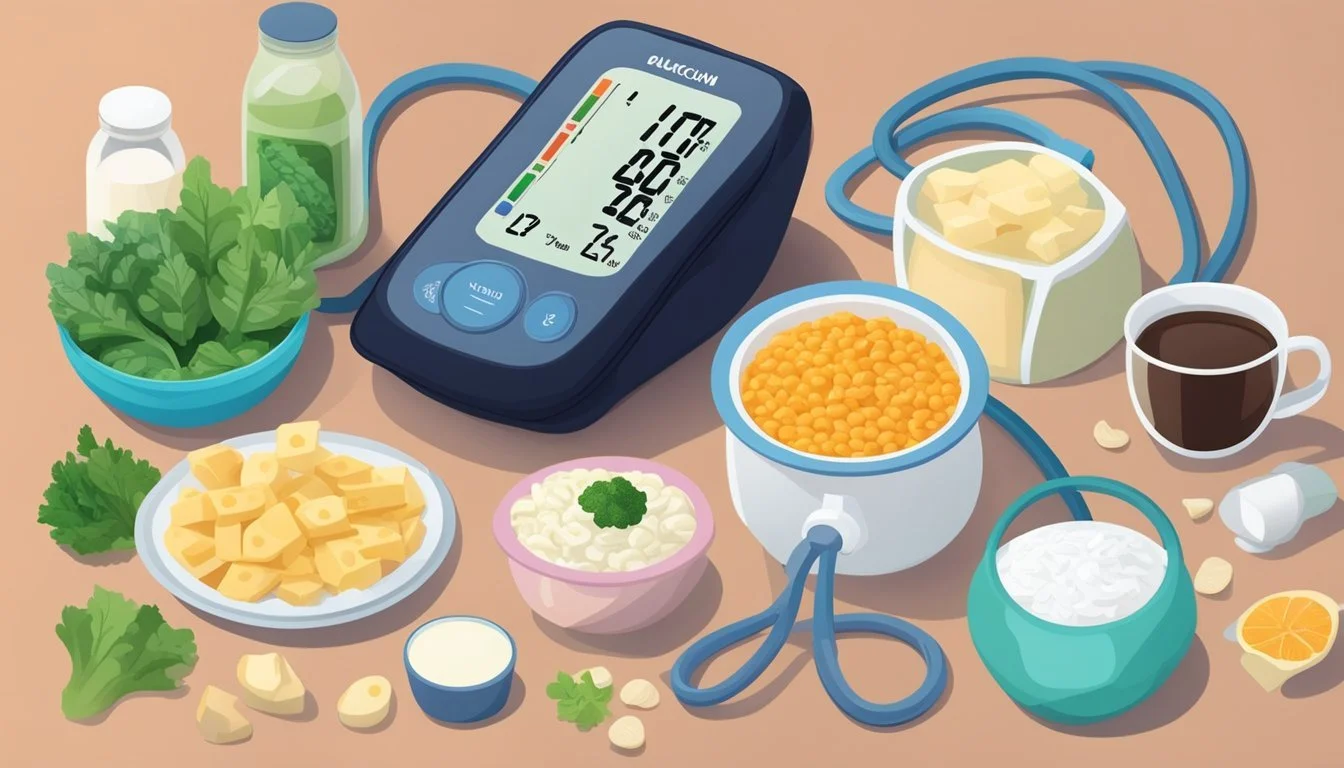What Are Some Good Sources of Calcium for Managing Hypertension
Essential Dietary Tips
Hypertension, commonly known as high blood pressure, is a prevalent health condition where the force of the blood against the artery walls is too high. Over time, this increased pressure can lead to heart disease, among other health complications. Managing blood pressure is crucial for maintaining cardiovascular health and reducing the risk of related conditions.
Calcium plays a significant role in regulating blood pressure. It is involved in the constriction and relaxation of blood vessels; adequate calcium intake may help blood vessels tighten and relax when necessary, contributing to more stable blood pressure readings. This regulatory effect is particularly important for individuals with hypertension, as it can aid in managing the condition more effectively.
Sources of calcium are abundantly available, and incorporating them into one's diet can be a strategic move for managing hypertension. While dairy products are well-known calcium-rich foods, plant-based options such as leafy greens, legumes, and some nuts and seeds also offer ample amounts of this essential mineral. For those with hypertension, a diet inclusive of various calcium sources may be an effective approach to support blood pressure management.
Understanding Hypertension and Its Connection to Calcium
Hypertension, also known as high blood pressure, is a significant health concern tightly interconnected with calcium, a mineral influencing cardiovascular health. This section explores the nature of hypertension and the role calcium plays in blood pressure regulation.
What is Hypertension?
Hypertension occurs when the blood pressure in a person's blood vessels is consistently too high, which can pose a severe threat to the heart and vascular system. Blood pressure is measured by the amount of blood the heart pumps and the resistance to blood flow in the arteries. Primary hypertension refers to high blood pressure without an identifiable cause, and it develops over time as a person ages.
Normal Blood Pressure: Systolic <120 mm Hg and Diastolic <80 mm Hg
Elevated Blood Pressure: Systolic 120-129 mm Hg and Diastolic <80 mm Hg
High Blood Pressure (Hypertension):
Stage 1: Systolic 130-139 mm Hg or Diastolic 80-89 mm Hg
Stage 2: Systolic at least 140 mm Hg or Diastolic at least 90 mm Hg
Role of Calcium in Controlling Blood Pressure
Calcium plays a pivotal role in blood pressure control. It acts as a cofactor in the contraction and relaxation of blood vessels, influencing vascular resistance and consequently blood pressure. A deficiency in calcium can lead to increased intracellular calcium in the smooth muscle cells of the arteries, resulting in vasoconstriction and elevated blood pressure.
Intracellular Calcium: When elevated, it causes vascular smooth muscle contraction, increasing blood pressure.
Calcium's Role: It helps to modulate the tone and health of the blood vessels, potentially lowering blood pressure.
The correlation between calcium and essential hypertension—high blood pressure with an unknown cause—suggests that proper calcium intake is a key factor in blood pressure management and cardiovascular health. Therefore, managing calcium levels is crucial in the non-pharmacological approach to controlling high blood pressure and maintaining heart health.
Dietary Sources of Calcium
The management of hypertension can be supported through a diet rich in calcium. This essential mineral is crucial for maintaining blood pressure levels, and various food groups offer abundant sources.
Dairy Products
Dairy products are the most well-known sources of calcium. Milk, cheese, and yogurt stand out as calcium-packed options. For individuals with lactose intolerance, lactose-free alternatives are available that still retain the calcium content necessary for a balanced diet.
Leafy Green Vegetables
Vegetables, particularly leafy greens, are substantial non-dairy calcium providers. Kale, collard greens, and bok choy offer significant amounts per serving. They also provide a wide range of minerals that can contribute positively to overall health and hypertension management.
Fish and Seafood
Canned salmon and sardines with bones are exceptional sources of calcium. A single can of these fish can deliver up to a quarter or more of the daily recommended calcium intake, which is especially beneficial for those following a diet focusing on managing hypertension.
Legumes and Nuts
Legumes such as beans and lentils contribute to calcium intake, along with protein and fiber, which are valuable in a heart-healthy diet. Additionally, almonds are recognized for their calcium content among nuts, making them a great snack for boosting calcium.
Fortified Foods
For those who struggle to meet their calcium needs through traditional sources, calcium-fortified foods are an excellent option. Foods and beverages like soy milk, almond milk, and certain fruit juices can be fortified with calcium, ensuring those with dietary restrictions can still maintain adequate intake.
Calcium Supplements and Hypertension
Calcium supplements may offer a non-prescriptive method to help manage hypertension, but should be considered with an understanding of the different types, potential benefits, and recommended dosages.
Types of Calcium Supplements
Calcium Carbonate: This is the most cost-effective type of calcium supplement, providing a high amount of elemental calcium; however, it requires stomach acid for absorption and is best taken with food.
Calcium Citrate: More expensive than calcium carbonate but does not require stomach acid for absorption, making it a viable option for individuals with reduced stomach acid.
Other Forms: Calcium supplements also come in the form of gluconate and lactate, and some may include additional nutrients like vitamin D or magnesium for improved absorption.
Potential Benefits and Risks
Calcium supplementation could help in lowering blood pressure, particularly in those who are calcium deficient. The relationship between calcium intake and blood pressure has been supported by research suggesting a link between higher calcium intake and lowered blood pressure levels.
However, excessive calcium intake, especially in supplement form, might lead to side effects such as kidney stones, constipation, or even increased risk of heart disease. Moreover, interactions with medications, particularly hypertension drugs, could alter their efficacy. It is crucial for individuals on high blood pressure medication to consult with healthcare providers prior to starting any calcium supplement.
Recommended Dosage
The ideal dosage of calcium for blood pressure management has not been conclusively established, but studies indicate doses ranging from 1000 mg to 1500 mg daily may be effective.
Adults aged 19-50: 1000 mg of elemental calcium is recommended per day.
For women over 50 and men over 70: 1200 mg is suggested.
It's important to note that the total daily intake from both dietary sources and supplements should not exceed these guidelines to avoid the risk of adverse effects.
Impact of Other Nutrients on Calcium Absorption and Hypertension
The management of hypertension through calcium intake is intricately connected to other nutrients that influence calcium absorption and blood pressure regulation. Certain micronutrients act synergistically to enhance these effects.
Magnesium
Magnesium plays a supportive role in calcium absorption and overall cardiovascular health. It aids in the transport of calcium across cell membranes, which is essential for muscle function, including that of the heart. A deficiency in magnesium can hinder calcium absorption and may lead to elevated blood pressure. Foods rich in magnesium include leafy greens, nuts, seeds, and whole grains.
Potassium
Potassium is another critical mineral for maintaining healthy blood pressure levels. It counteracts the effects of sodium, a well-known contributor to hypertension. By promoting sodium excretion and helping to relax blood vessel walls, potassium can help to reduce blood pressure. Sources of potassium are found in bananas, oranges, potatoes, and tomatoes.
Vitamin D
Vitamin D is indispensable for the body to absorb calcium effectively. Low levels of vitamin D can result in suboptimal calcium absorption, potentially affecting bone health and blood pressure control. Safe sun exposure, fatty fish, egg yolks, and fortified foods are good sources of vitamin D. Supplementation may be considered when dietary intake is insufficient or sunlight exposure is inadequate.
Factors Influencing Calcium Efficacy in Hypertension Management
Calcium has a documented role in blood pressure regulation, but its efficacy can be influenced by individual biological and lifestyle factors. Understanding these factors can optimize calcium's role in managing hypertension.
Age and Sex
Both age and sex are significant determinants in how calcium affects blood pressure control. Men and women may experience different benefits from calcium intake. For instance, premenopausal women often have lower rates of hypertension compared to men of similar ages, potentially due to the protective effects of estrogen. As people age, calcium metabolism changes, which could modify the mineral's impact on systolic and diastolic blood pressure.
Hormonal Changes
Hormonal fluctuations, particularly involving hormones like estrogen, can modulate the effect of calcium on blood pressure. During menopause, the decline in estrogen may diminish calcium absorption, leading to a greater need for calcium to maintain blood pressure control. Moreover, hormonal changes in conditions like diabetes can affect calcium efficacy in managing hypertension.
Genetic and Lifestyle Factors
Several genetic and lifestyle factors significantly impact calcium efficacy in hypertension management:
Alcohol: Excessive consumption can inhibit calcium absorption and exacerbate hypertension.
Stress and Overweight: Stress-induced hormonal changes and adiposity can both affect calcium metabolism and hypertension.
Physical Activity: Regular exercise enhances calcium absorption and can lower blood pressure, while a lack of physical activity can reduce these benefits.
Body Mass Index (BMI): Higher BMI can be associated with higher blood pressure; however, the relationship between calcium intake, weight loss, and blood pressure control needs more elucidation.
By considering these factors, individuals and healthcare providers can better tailor dietary and supplemental calcium to manage hypertension effectively.
Scientific Evidence on Calcium and Blood Pressure
Scientific studies have established a relationship between calcium intake and blood pressure regulation. Research includes various approaches such as randomized controlled trials, prospective cohort studies, and meta-analyses. These studies have shed light on the impact of calcium on hypertensive disorders and cardiovascular risk factors.
Randomized Controlled Trials
Randomized controlled trials (RCTs) represent the gold standard in clinical research for establishing causal relationships. They have consistently indicated that calcium supplementation can lead to modest reductions in systolic and diastolic blood pressure. For example, in adults with hypertension, an increase in dietary calcium intake to at least 800 mg per day may reduce systolic blood pressure by up to 4 mm Hg and diastolic pressure by up to 2 mm Hg. When dietary calcium does not meet the Daily Recommended Intake (DRI), supplementation ranging from 1,000 mg to 1,500 mg per day is often considered by clinicians to aid in managing blood pressure.
Prospective Cohort Studies
In the realm of prospective cohort studies, the longitudinal follow-up of participants provides insights into the long-term effects of calcium intake on health outcomes. Such studies have indicated the potential role of calcium in reducing the global burden of hypertensive disorders and related complications like ischaemic heart disease and stroke mortality. The findings suggest that higher calcium intake is associated with better blood pressure control, though they stop short of proving causation.
Meta-Analyses
Meta-analyses, which synthesize data from multiple studies, give a broad perspective on the effects of calcium intake on blood pressure and hypertensive disorders. Meta-analytical results show that calcium supplementation can lead to an overall reduction in basal blood pressure, particularly in populations with low basal calcium intake. Furthermore, these analyses suggest possible improved pregnancy outcomes related to blood pressure regulation. However, it is worth noting that the degree of blood pressure reduction tends to vary by age, with greater effects observed in younger individuals.
Strategies for Hypertension Prevention and Management
Efficient management and prevention of hypertension can significantly reduce the risk of cardiovascular diseases. This section will explore practical strategies focusing on lifestyle modifications, dietary calcium interventions, and food fortification to control high blood pressure.
Lifestyle Modifications
Lifestyle choices play a crucial role in both the prevention and management of hypertension. Patients are advised to maintain a healthy weight, engage in regular physical activity, and adopt a balanced diet, which includes low sodium options. It is essential to limit the intake of high-sodium foods, as excess sodium can lead to increased blood pressure. Strategies such as reading nutrition labels to choose lower-sodium choices and reducing processed foods intake can aid in achieving a low sodium diet.
Dietary Calcium Interventions
Calcium intake has been linked to lower blood pressure levels. Adults can benefit from incorporating high-calcium foods into their daily diet as a preventive measure against hypertension:
Dairy Products: Skim milk and low-fat yogurt are excellent sources of calcium which can be included in a regular diet.
Leafy Greens: Vegetables like kale, collard greens, and turnip greens are packed with calcium and other vital nutrients.
Calcium-Fortified Foods: Foods such as cereal, orange juice, and plant-based milk often have added calcium.
Research has shown that calcium supplementation can significantly reduce the risk of hypertension complications during pregnancy, suggesting the importance of adequate calcium intake for managing blood pressure.
Food Fortification
Food fortification, the addition of nutrients to foods, is another strategy to control hypertension. This approach is beneficial in populations where the dietary intake of necessary nutrients like calcium is often below recommended levels. For instance, fortifying common foods like bread or juice with calcium not only helps in managing blood pressure but also in ensuring a balanced diet for broader audiences. By increasing the availability of fortified foods, populations gain better access to essential nutrients necessary for hypertension prevention.
Considerations for Specific Populations
In managing hypertension through calcium intake, special considerations must be given to specific populations who have unique dietary needs. These include pregnant women who require calcium for better pregnancy outcomes, elderly individuals who need to maintain bone health to prevent conditions like osteoporosis, and those at risk of kidney diseases who must balance their nutrient intake carefully.
Pregnant Women
For pregnant women, adequate calcium intake is crucial as it is associated with a lower risk of developing hypertensive disorders. These conditions can affect pregnancy outcomes, so a diet rich in high-calcium foods or appropriate supplementation is often recommended. Sources such as dairy products, leafy greens, and fortified foods should be considered.
Elderly Individuals
Elderly individuals, particularly those who are normotensive, can benefit from calcium to maintain blood pressure levels and bone density. A daily intake sourced from dairy products like milk, cheese, and yogurt, as well as non-dairy options like fortified plant milks and tofu, is beneficial in keeping their systolic and diastolic blood pressure within normal ranges.
People at Risk of Kidney Diseases
Individuals susceptible to kidney diseases must approach calcium consumption with caution. They need to prevent excessive calcium load, which could exacerbate kidney conditions, while ensuring they have enough to help manage hypertension if present. They might opt for low-oxalate vegetables like broccoli and kale as sources of calcium, and should coordinate with healthcare providers to balance their needs.
Conclusion
Incorporating calcium-rich foods into one's diet is a strategic approach that may aid in managing hypertension. Calcium plays a vital role by assisting in the regulation of blood pressure, consequently offering protection against cardiovascular diseases. While dairy products are traditional calcium sources, individuals should also consider plant-based alternatives—these not only diversify dietary patterns but cater to those with dairy intolerance or preference for a vegan diet.
Dairy: milk, cheese, yogurt
Plants: leafy greens, almonds, tofu
Fortified foods: cereals, some plant milks
It is important to recognize that too much calcium—beyond the recommended dietary allowance—does not provide additional benefits to blood pressure management and may have unwanted effects. The subtle balance of maintaining adequate calcium intake is key, avoiding excessive quantities that might contribute to risks such as prostate cancer.
Integrating calcium into the diet can be achieved through careful selection of foods or, when necessary, with appropriate supplementation, always following a healthcare provider's guidance. Despite the allure of supplements, they are not a panacea and should complement a balanced diet, not replace it.
Recommended Dietary Allowance for Calcium:
Adults aged 19-50: 1,000 mg/day
Women over 50 and men over 70: 1,200 mg/day
Management of hypertension through diet extends beyond calcium to include other minerals and lifestyle choices. Always consult with a healthcare professional before making significant changes to diet or starting supplements, particularly for individuals with pre-existing health conditions.






